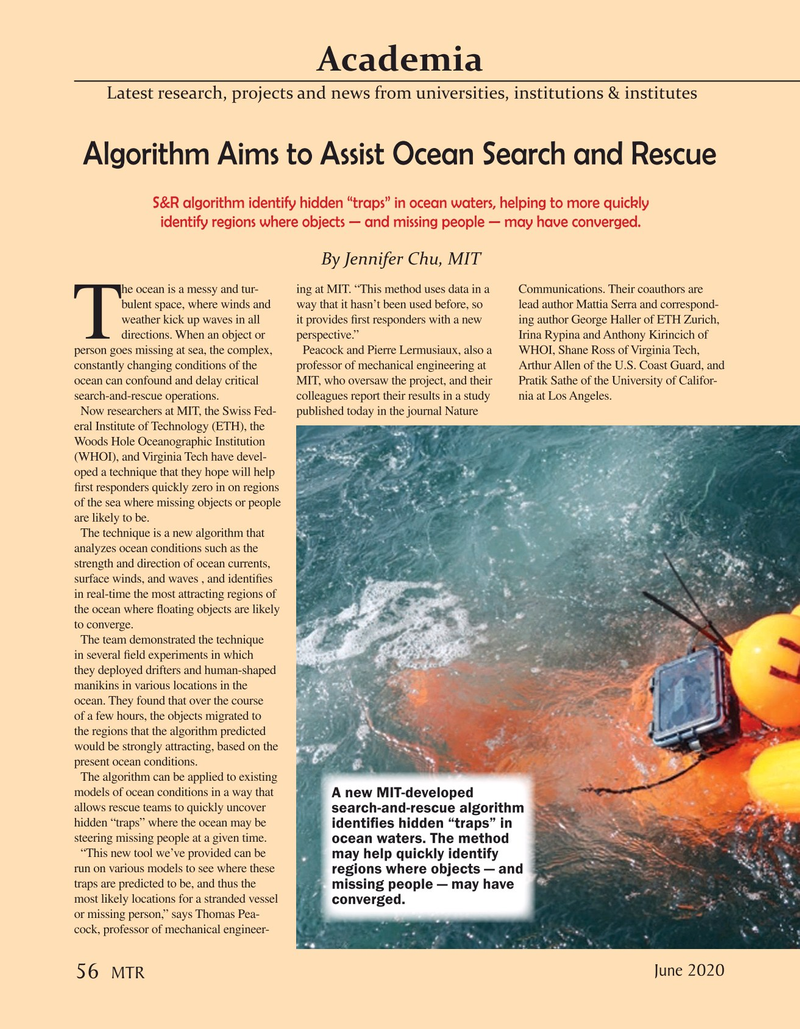
Page 56: of Marine Technology Magazine (June 2020)
Read this page in Pdf, Flash or Html5 edition of June 2020 Marine Technology Magazine
Academia
Latest research, projects and news from universities, institutions & institutes
Algorithm Aims to Assist Ocean Search and Rescue
S&R algorithm identify hidden “traps” in ocean waters, helping to more quickly identify regions where objects — and missing people — may have converged.
By Jennifer Chu, MIT he ocean is a messy and tur- ing at MIT. “This method uses data in a Communications. Their coauthors are bulent space, where winds and way that it hasn’t been used before, so lead author Mattia Serra and correspond- weather kick up waves in all it provides frst responders with a new ing author George Haller of ETH Zurich,
Tdirections. When an object or perspective.” Irina Rypina and Anthony Kirincich of person goes missing at sea, the complex, Peacock and Pierre Lermusiaux, also a WHOI, Shane Ross of Virginia Tech, constantly changing conditions of the professor of mechanical engineering at Arthur Allen of the U.S. Coast Guard, and ocean can confound and delay critical MIT, who oversaw the project, and their Pratik Sathe of the University of Califor- search-and-rescue operations. colleagues report their results in a study nia at Los Angeles.
Now researchers at MIT, the Swiss Fed- published today in the journal Nature eral Institute of Technology (ETH), the
Woods Hole Oceanographic Institution (WHOI), and Virginia Tech have devel- oped a technique that they hope will help frst responders quickly zero in on regions of the sea where missing objects or people are likely to be.
The technique is a new algorithm that analyzes ocean conditions such as the strength and direction of ocean currents, surface winds, and waves , and identifes in real-time the most attracting regions of the ocean where foating objects are likely to converge.
The team demonstrated the technique in several feld experiments in which they deployed drifters and human-shaped manikins in various locations in the ocean. They found that over the course of a few hours, the objects migrated to the regions that the algorithm predicted would be strongly attracting, based on the present ocean conditions.
The algorithm can be applied to existing models of ocean conditions in a way that
A new MIT-developed allows rescue teams to quickly uncover search-and-rescue algorithm hidden “traps” where the ocean may be identifes hidden “traps” in steering missing people at a given time.
ocean waters. The method “This new tool we’ve provided can be may help quickly identify run on various models to see where these regions where objects — and traps are predicted to be, and thus the missing people — may have most likely locations for a stranded vessel converged.
or missing person,” says Thomas Pea- cock, professor of mechanical engineer- June 2020 56 MTR

 55
55

 57
57
